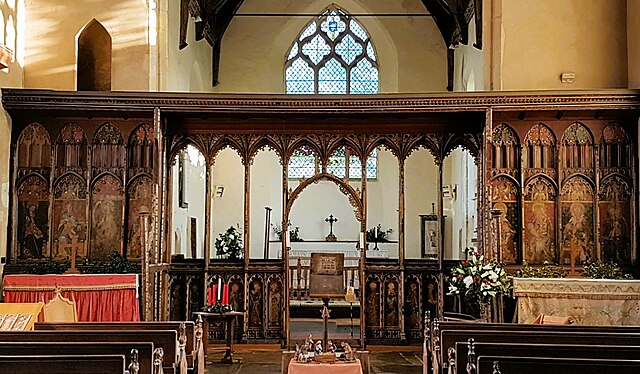The Ranworth rood screen at Church of St Helen, Ranworth, Norfolk, is a wooden medieval rood screen that divides the chancel and nave, and was originally designed to act to separate the laity from the clergy. It is described by English Heritage as "one of England's finest painted screens".
Image: Rood screen at St Helen's Church, Ranworth, Norfolk
Image: St Helen's Church, Ranworth rood screen detail (Archangel Michael)
Image: St Helen's Church, Ranworth rood screen detail (St Lawrence)
Image: St Helen's Church, Ranworth The Virgin Mary panel
The rood screen is a common feature in late medieval church architecture. It is typically an ornate partition between the chancel and nave, of more or less open tracery constructed of wood, stone, or wrought iron. The rood screen was originally surmounted by a rood loft carrying the Great Rood, a sculptural representation of the Crucifixion. In English, Scottish, and Welsh cathedrals, monastic, and collegiate churches, there were commonly two transverse screens, with a rood screen or rood beam located one bay west of the pulpitum screen, but this double arrangement nowhere survives complete, and accordingly the preserved pulpitum in such churches is sometimes referred to as a rood screen. At Wells Cathedral the medieval arrangement was restored in the 20th century, with the medieval strainer arch supporting a rood, placed in front of the pulpitum and organ.

15th-century rood screen from the chapel of St Fiacre at Le Faouet Morbihan, France, including the two thieves on either side of Christ
Crucifixion atop Rood Screen, Anglo-Catholic Church of the Good Shepherd (Rosemont, Pennsylvania)
East end of the 8th-century Roman basilica of Santa Maria in Cosmedin in Rome, showing the altar, under a 13th-century ciborium behind a templon screen of columns. The foreground forms the liturgical choir, surrounded by low cancelli screens, to which are attached two ambos, left and right.
Rood and beam of 1275, but no screen, at Öja Church on the island of Gotland in Sweden, where many exceptional roods have survived.








